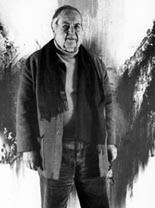
Duvillier was an internationally acclaimed post-war abstract painter and one of the most intriguing, obsessed with trying to capture the energy of the natural elements, for which the critic Charles Estienne would refer to Duvillier as “the poet of the elements”. This powerful work “Les Foudres dans la Mer” is a superb example of the artist’s important sea series, for which he first became inspired in 1954 when he visited North Finistere on the Atlantic coast. Although associated with the Abstraction Lyrique group, Duvillier’s work is inherently more complex incorporating a fundamental symbolist aspect, which historians have referred to as “cénesthésique”.
The son of an art teacher, Duvillier was taught to paint at a young age and would regularly visit museums and galleries. In 1935 he attended the École des Beaux Arts in Paris where he studied under Charles Guerin a protégé of Gustave Moreau. During the Occupation however he was imprisoned for participating in the Resistance and sent to the Ukraine and then Poland. But he managed to exhibit for the first time in Krakow in a show called “La Genese”. In 1945 he returned to Paris and was soon exhibiting in the avant-garde salons such as the Salons des Moins de Trente Ans and the Salon de Mai. Invitations to several group shows followed including in 1947 “Expressionisme et Humanisme” at Galerie Guenegaud, and in 1951 “Jeune Peintures” Galerie La Hune, with Debré, Messagier, and Pons. Then in 1952 the eminent critic Charles Estienne invited him to exhibit in “Peintres de la Nouvelle Ecole de Paris” at Galerie Babylon, with the leading painters Hartung, Degottex and Poliakoff, which sealed his reputation, and the following year he participated in “Young European Painters” at the Guggenheim Museum in New York. In 1953 Duvillier co-founded the avant-garde Salon d’Octobre in Paris. Charles Estienne then curated Duvillier’s first solo show in Paris at Galerie l’Etoile in 1955, but it wasn’t until 1957 that Duvillier began to experiment with the more monochromatic palette that would define his oeuvre. These new works he first exhibited in Dusseldorf at Gallery 22. This was the beginning of several profoundly intensive series such as “La Mer”; “Les Tourbillons”; “Les Vents”; “Les Orages”; “Le Cycle Aerien”, which established Duvillier’s international reputation.
Duvillier went on to exhibit extensively around the world, including in 1960 at the Maison des Princes, Perugia; and the Bader Gallery, Washington; 1961 “La Mer des Vents” Galerie Smith, Brussels; 1962 Nitta Gallery, Tokyo; 1964 Byron Gallery, New York curated by J. Alvard; 1966 Smithsonian Institution, Washington; 1967 French Pavillion, Universal Exhibition in Montreal; 1967 “Sea paintings” Eurogalerie, Montreux; 1968 “An adventure of Abstract Art”, Musée Galerie Paris; 1968 “Three years of living art”, Fondation Maeght; 1968 “Contemporary French Painting” Museums of Belgrade, Prague, Warsaw, Bucharest, Zagreb; 1969 “From Man to the Cosmos”, Palais des Congres, Vienna; 1970 Intergrafik Berlin; 1971 Hanover, Munich, Cologne, Antwerp, Lisbon, Milan, Florence; 1972 Musée d’Art Moderne, Paris; International Cultural Center Amsterdam; 1973 Musée des Beaux Arts Lyon; 1976 Musée Le Havre; 1989 retrospective Musée de Morlaix.
The artist is now represented in numerous museums of modern art worldwide including: Solomon Guggenheim Museum, New York; Smithsonian Institute, Washington; HIS Foundation, Atlanta; Centre National d’Art Contemporain, Paris; Musée d’Art Moderne, Paris; Contemporary Art Museum, Skopje; Musée Cantonal, Lausanne.